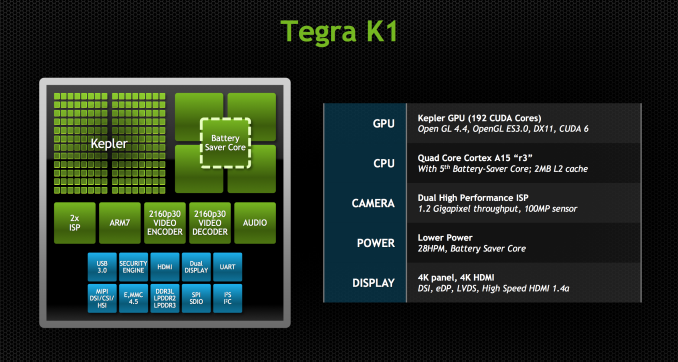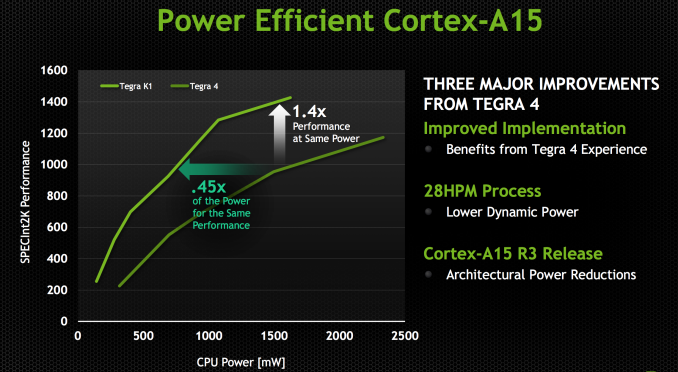NVIDIA Tegra K1 Preview & Architecture Analysis
by Brian Klug & Anand Lal Shimpi on January 6, 2014 6:31 AM EST
NVIDIA has taken to using CES as its platform for launching members of its Tegra mobile SoC family. This year was no different as it shifted branding a bit in its announcement of the Tegra K1, formerly known as Project Logan.
With Tegra 2 NVIDIA’s big selling point was being first to dual-core in Android. Tegra 3 attempted to do the same with being first to quad-core. Tegra 4 just made things faster. Tegra K1 on the other hand does away with the gimmicks and instead focuses on fundamentals.
The SoC will come in two versions, one version with a quad-core (4+1) Cortex-A15, and one that leverages two of NVIDIA’s own 64-bit ARMv8 Denver CPUs. More importantly, they both ship with a full implementation of NVIDIA’s Kepler GPU architecture. In fact, Tegra K1 marks a substantial change in the way NVIDIA approaches mobile GPU design. From this point forward, all mobile GPUs will leverage the same architectures as NVIDIA’s desktop parts. As if that wasn’t enough, starting now, all future NVIDIA GeForce designs will begin first and foremost as mobile designs. NVIDIA just went from playing with mobile to dead serious in a heartbeat.
Tegra K1 will also be NVIDIA's launch vehicle for Project Denver, it's first fully custom ARMv8 CPU core. More on that in a bit.
CPU Option 1: Quad-Core ARM Cortex A15
Tegra K1 will ship in two configurations. The first went into production at the end of December 2013, is shipping to OEMs this quarter and will be in devices, allegedly, in the first half of 2014. This first configuration is based on ARM’s Cortex A15 CPU core.
Much like Tegra 4, the A15 version of Tegra K1 features four Cortex A15s synthesized for high frequencies and a fifth Cortex A15 that’s optimized for low power/frequency operation. The fifth core, what NVIDIA likes to call a shadow or companion core, is swapped in during periods of very low CPU usage (e.g. idle, screen off in your pocket updating new tweets/emails). As CPU demands grow the companion core is switched out for one of the four high performance cores, then two, then three and finally all four can be plugged in at once (but never five).
Tegra K1 ships with a newer revision of the Cortex A15 (r3p3) than what was in Tegra 4 (r2p1). ARM continuously updates its processor IP, with each revision bringing bug fixes and sometimes performance improvements. In the case of Tegra K1’s A15s, the main improvements here have to do with increasing power efficiency. With r3p0 (which r3p3 inherits) ARM added more fine grained clock gating, which should directly impact power efficiency.
The combination of the newer Cortex A15 revision and the move to 28nm HPM give Tegra K1 better performance at the same power consumption or lower power consumption at the same performance level. The reality tends to be that mobile OEMs will pursue max performance and not optimize for a good performance/power balance, but it’s at least possible to do better with Tegra K1 than with Tegra 4.
The max CPU clock goes up from 1.9GHz to 2.3GHz, a direct result of the move to 28nm HPM; 2.3GHz is the max CPU clock regardless of the number of active cores. The max performance increase over Tegra 4 running at max clocks will be just over 20%.
NVIDIA hasn’t made any changes to the L1/L2 cache configuration with Tegra K1. We’re still dealing with a shared 2MB L2 and 32KB/32KB L1s (I$+D$) per core.
The companion core can scale up to 1GHz, but tends to run at around 500MHz.
Feeding the CPU (and GPU) cores is a 64-bit wide LPDDR3 memory interface. NVIDIA will offer Tegra K1 in PoP, discrete and another package revision for standard clamshell notebook use.












88 Comments
View All Comments
Nenad - Monday, January 13, 2014 - link
That is not real picture of GPUs/CPUs, it is photoshoped, so we do not know relative size of A15 and Denver cores.chizow - Monday, January 6, 2014 - link
Of course they would, designating it as simply dual-core would intimate it's a downgrade when it clearly is not.MrdnknnN - Monday, January 6, 2014 - link
"As if that wasn’t enough, starting now, all future NVIDIA GeForce designs will begin first and foremost as mobile designs."I guess I am a dinosaur because this makes me want to cry.
nathanddrews - Monday, January 6, 2014 - link
Why? It was the best thing that ever happened to Intel (Core). Desktop graphics are in a rut. Too expensive, not powerful enough for the coming storm of high frame rate 4K and 8K software and hardware.HammerStrike - Monday, January 6, 2014 - link
From a gaming perspective Intel's focus on mobile has let to 10%-15% performance increases in their desktop line whenever they release a new chip series. That's pretty disappointing, from a gaming performance perspective, even though I understand why they are focusing there.Also, I disagree with you on desktop graphics - this is a golden time for them. The competition in the $200-$300 card range is fierce, and there is ton of great value there. Not sure why you think there is a "storm" of 4k and 8k content coming any time soon, as there isn't, but even 2x R9 290, $800 at MSRP (I know the mining craze has distorted that, but it will correct) can drive 4K today. Seeing as most decent 4K monitors are still $3000+, I'd argue it is the cost of the displays, and not the GPU's, that is holding back wider adaptation.
As long as nVidia keeps releasing competitive parts I really don't care what their design methodology is. That being said, power efficiency is the #1 priority in mobile, so if they are going to be devoting mindshare to that my concern is top line performance will suffer in desktop apps, where power is much less of an issue.
OreoCookie - Monday, January 6, 2014 - link
Since Intel includes relatively powerful GPUs in their CPUs, discrete GPUs are needed only for special purposes (gaming, GPU compute and various special applications). And the desktop market has been contracting for years in favor of mobile computers and devices. In the notebook space, thanks to Intel finally including decent GPUs in their CPUs, only high-end notebooks come with discrete GPUs. Hence, the market for discrete GPUs is shrinking (which is one of the reasons why nVidia and AMD are both in the CPU game as well as the GPU game).MrSpadge - Monday, January 6, 2014 - link
> From a gaming perspective Intel's focus on mobile has let to 10%-15% performance increases in their desktop line whenever they release a new chip series. That's pretty disappointingThat's not because of their power efficiency oriented design, it's because their CPU designs are already pretty good (difficult to improve upon) and there's no market pressure to push harder. And as socket 2011 shows us: pushing 6 of these fat cores flat out still requires 130+ W, making these PCs the dinosaurs of old again (-> not mass compatible).
Sabresiberian - Monday, January 6, 2014 - link
I think you are misunderstanding the situation here. What will go in a mobile chip will be the equivalent of one SMX core, while what will go in the desktop version will be as many as they can cool properly. With K1 and Kepler we have the same architecture, but there is one SMX in the coming mobile solution, and 15 SMXs in a GeForce 780Ti. So, 15x the performance in the 780Ti (roughly) using the same design.Maxwell could end up being made up of something like 20 SMXs designed with mobile efficiency in mind; that's a good thing for those of us playing at the high end of video quality. :)
MrSpadge - Monday, January 6, 2014 - link
This just means they'll be optimized for power efficiency first. Which makes a lot of sense - look at Haitii, it can not even reach "normal" clock speeds with the stock cooler because it eats so much power. Improving power efficiency automatically results in higher performance becoming achievable via bigger dies. What they decide to offer us is a different story altogether.kpb321 - Monday, January 6, 2014 - link
My initial reaction was a little like MrdnknnN but when I thought about it I realized that may not be a bad thing. Video cards at this point are primarily constrained on the high end by power and cooling limitations more than anything else. The R9 is a great example of this. Optimizing for mobile should result in a more efficient design which can scale up to good desktop and high end performance by adding on the appropriate memory interfaces and putting down enough "blocks" SMXs in nvidia's case. They already do this to give the range of barely better than integrated video cards to top end 500+ dollar cards. I don't think the mobile focus is too far below the low end cards of today to cause major problems here.